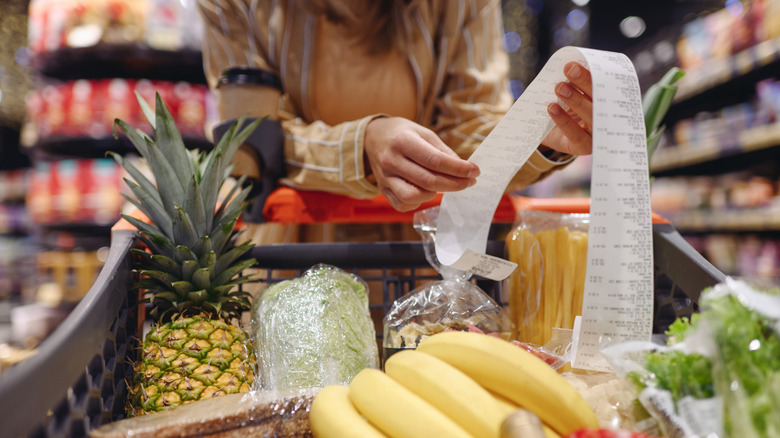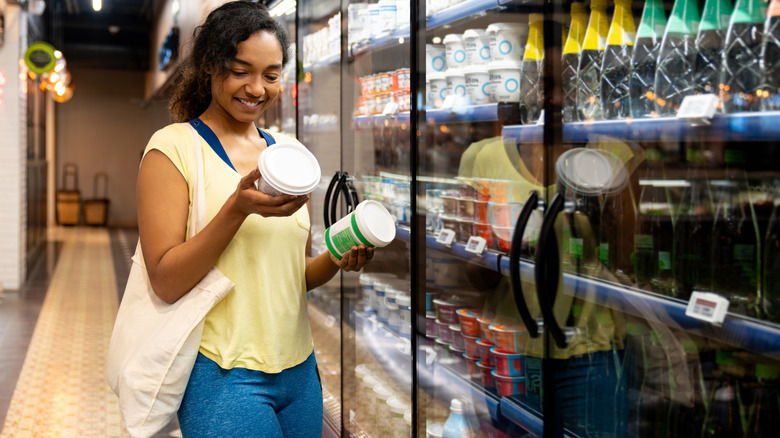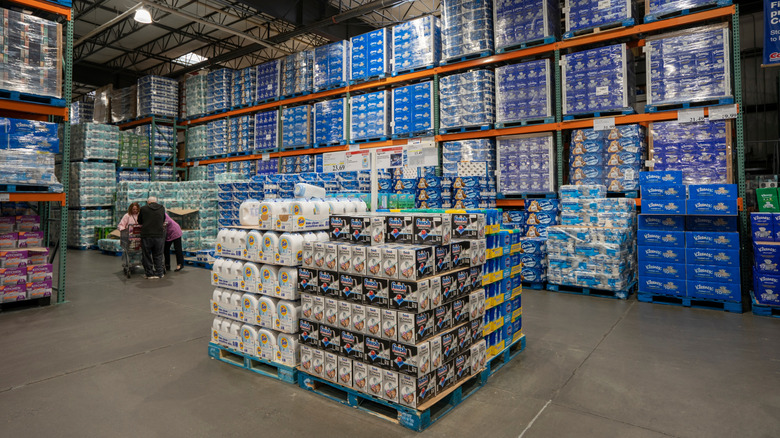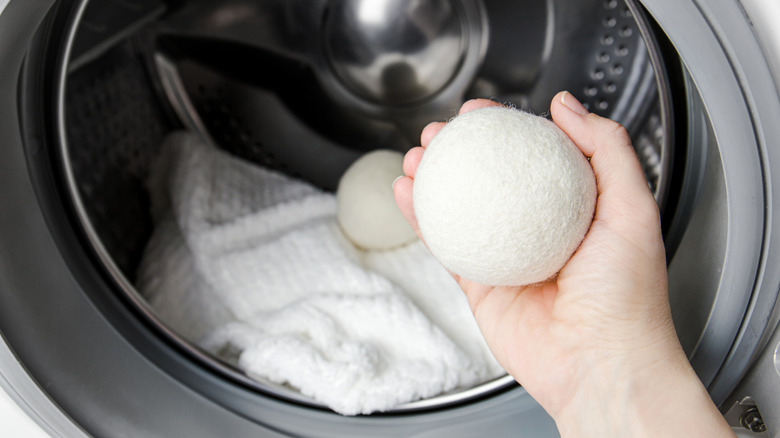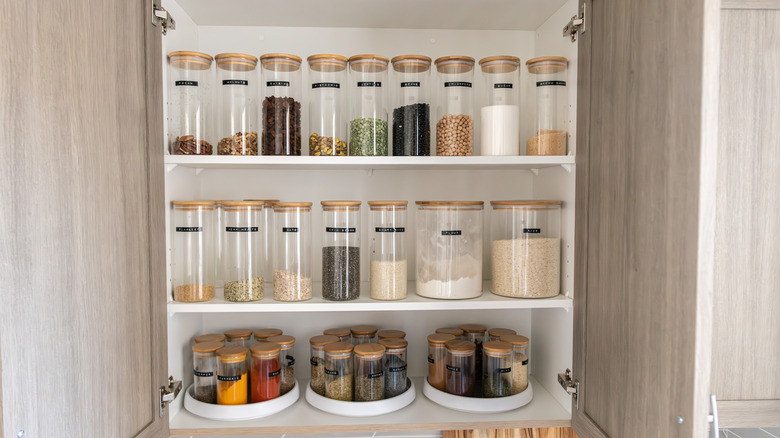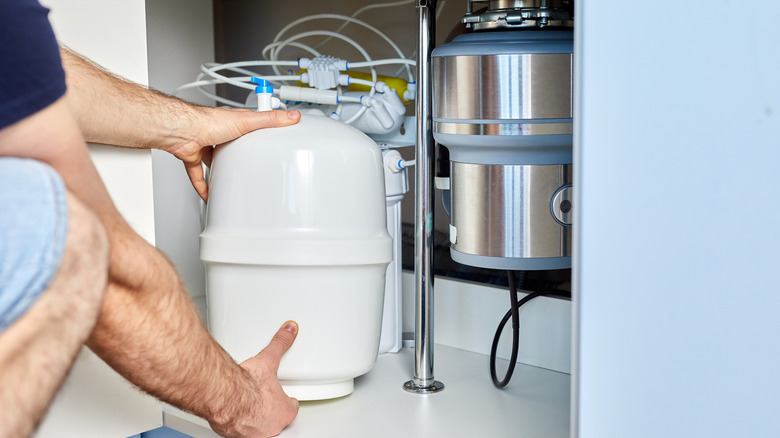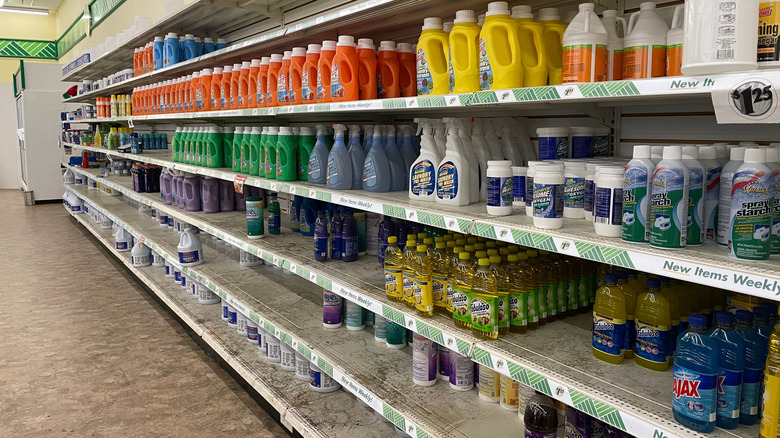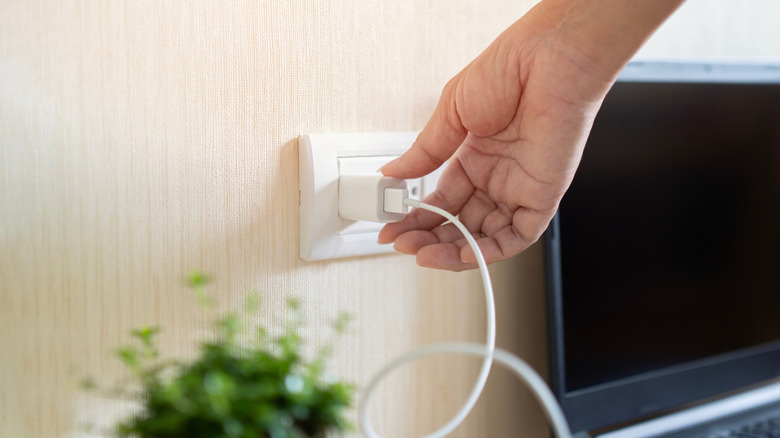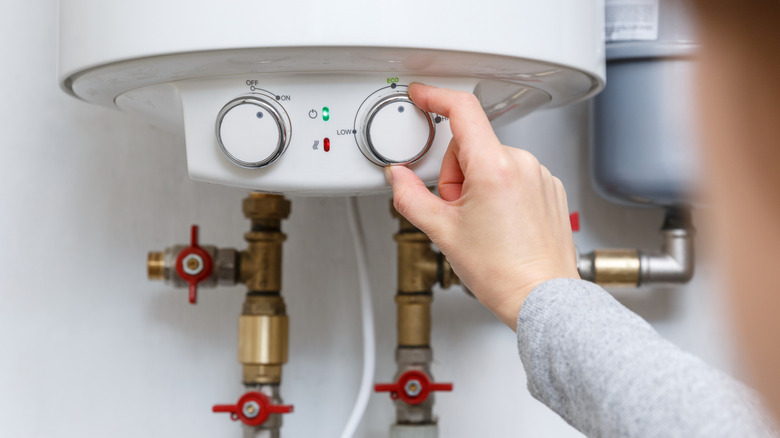Easy Tips And Tricks To Save More Money On Household Essentials
We may receive a commission on purchases made from links.
As the prices of household essentials continue to rise, it's becoming increasingly difficult to stretch the budget. A 2024 analysis conducted by Bank of America revealed that nearly half of Americans surveyed felt like they were living paycheck to paycheck. The data also showed that 30% of households were spending 90% or more of their income on necessities. While there are certain expenses you have to pay to keep a roof over your head, there's a lot you can do to reduce the cost of bills. For example, the Natural Resources Defense Council (NRDC) estimates that Americans waste around $19 billion of electricity each year, indicating that there's more we can do to conserve energy and lower our monthly payments.
If you don't already, start tracking everything you purchase so you know where your money is going. It's easy to spend $5 here and $10 without thinking it'll affect much, but all of those small purchases will add up by the end of the month. Setting and sticking to a budget and planning ahead don't require a lot of effort, but can result in savings without you even realizing it. For example, by eating before you go grocery shopping and planning your meals ahead of time you can help prevent impulse buying or resorting to takeout. You'll be surprised at how a few simple adjustments can add up to big savings throughout the year.
Switch to generic brands
Is paying for name-brand products worth the extra cost? Although sometimes the higher price is justified, many times you're paying extra for marketing and high-end packaging. To become household names, these well-known companies heavily invest in commercials and other advertisements to get in front of as many eyes as possible, building familiarity and trust. However, not only do their generic alternatives often use the same ingredients, but sometimes, they're even made in the same factory. Consumer Reports surveyed over 24,000 consumers, with 72% stating they've purchased store brands within the previous month, and 74% expressing high levels of satisfaction with their generic counterparts.
By opting for generic or store brands, you could save up to 40% on your grocery bills. When you add up how often you grocery shop, that's thousands of dollars of potential savings each year. Next time you head to the grocery store, check the labels to determine if the cheaper option has similar qualities. If they have the same core ingredients for a fraction of the cost, it may be worth giving the off-brand product a shot. To ease the switch, you can start by swapping out a few products at a time rather than testing out a cartful of groceries at once. While you might be willing to splurge on a few favorites, you may also find some store-brand items you love even more than the pricey versions.
Buy in bulk
It can feel like the moment you stock up on household essentials, you blink and suddenly need to restock all over again. Thankfully, there are lots of household items you can buy in bulk to save you money and time, but you must plan these purchases strategically. When you buy large quantities at once, you're typically paying less per unit than you would at the average supermarket. Additionally, buying more in one shopping trip means you'll free up more time before you need to head to the store again, which can help limit impulse spending.
One mistake many people make when buying in bulk is going in without a plan. Make a strict list, and do your best to stick with it, only grabbing items you know for certain won't go to waste. Start by considering which non-food products you regularly use, such as trash bags, paper towels, toilet paper, toothpaste, sponges, and household cleaners. If you have the storage, these items can sit on your shelves for years, so there's little to no chance they'll go to waste. You can also stock up on food items that have a long shelf-life, like coffee, flour, spices, and canned goods, but avoid perishable foods unless you have a plan for them. While bulk shopping is commonly associated with stores like Sam's Club or Costco, you can avoid the membership fee by buying in bulk online or at retailers like Amazon, Walmart, and Target. Buying in bulk doesn't always have to look like heading to a warehouse — it can also mean simply buying larger packs (which are typically a better deal) or seriously stocking up whenever you see a good sale on non-perishable items.
Switch to reusable items
Swapping disposable items for reusable products isn't just good for the planet; it can also be easier on your wallet. According to the U.S. Census Data and Simmons National Consumer Survey (NHCS), the average American uses eight or more rolls of paper towels each month, or nearly 100 rolls each year. Now, think about all the other disposables you regularly use, like plastic wrap and dryer sheets. These throwaway items add up fast, both in cost and waste. However, with so many disposables having multi-use alternatives, you can make simple swaps that reduce waste and save you tons of funds each year.
Because multi-use products are built to last, they're often more durable and effective than disposables. For example, these Swedish Dishcloths from SuperScandi are a perfect way to reduce paper towel usage. Using wool dryer balls, such as the Budieggs Organic 6-Pack, in place of dryer sheets will save you money while also preventing wrinkles and shortening drying time. You can also exchange plastic baggies for reusable and washable ones, like the SPLF 10 Pack Reusable Quart Freezer Bags, which are leak-proof and easy to clean. There are multi-use alternatives for nearly everything, including plastic wrap, paper towels, straws, and coffee filters. Because making the switch from disposables to reusable items requires an initial investment, start with a few staples and gradually make changes as your budget allows.
Organize your fridge and pantry
We've all made the mistake of restocking our fridge or pantry, only to realize we've purchased duplicate items. In fact, a survey conducted by the Natural Resources Defense Council (NRDC) found that the average American household wastes about 6 cups of edible food per week. Some of this waste comes from food hiding in the back of the fridge or pantry, only to be discovered after it has expired. Creating a system to keep your food storage organized allows you to easily keep track of everything you have, resulting in less waste and more money in your wallet.
Before you organize, throw out anything that's expired or won't get eaten to free up space in your fridge and pantry. Assign a specific purpose for each shelf, like dedicating an area for foods that need to be eaten first, and label any unmarked containers with the expiration date and food description. To keep your food fresh for longer, store foods that aren't at risk of spoiling, like condiments, on the door, where the temperature tends to fluctuate. The bottom shelf stays the coldest, making it perfect for foods that spoil easily, such as meat. The best way to organize your pantry is to keep everything visible, so save space by transferring products in bulky boxes to clear containers to free up room while making it easier to see exactly what you have. Place similar products together so you always know exactly where to look.
Install a water filtration system
From drinking it to running appliances, water is a resource that we can't go without. So, it's a good idea to make sure yours is clean, safe, and not costing more than it should. Filtration systems eliminate contaminants like chlorine, sediment, heavy metals, and even bacteria from the water. According to the Container Recycling Institute, Americans toss out roughly 60 million plastic water bottles each day. With a gallon of tap water typically costing less than a penny, it's far cheaper than the disposable alternative.
Each household has something different flowing out of the faucet, so there are different types of filters based on what your goals are. Whole-house water filtration systems can cost anywhere from hundreds to thousands of dollars, but they may pay off in the future. Alternatively, you can opt for more cost-effective solutions, like a sink filter or water pitcher filter, such as the Brita Metro Pitcher. Depending on how often you drink bottled water and your preferred brand, making the switch to filtered tap water could save you hundreds to over $1,000 each year.
Get what you can at discount stores
According to Aldi's pricing analysis, consumers can save an average of 36% by buying the bulk of their groceries at their stores. Their low prices come from cutting out the middleman and offering Aldi-exclusive brands, encouraging shoppers to bring reusable bags, and using a quarter deposit system on their carts. Because they save costs on marketing, plastic bags, and extra staff, they're able to pass the savings on to their customers. Discount stores, like Dollar Tree, also keep prices low by selling private-label products, purchasing in bulk, and operating in low-rent areas. While you may not be able to do a full grocery haul at a dollar store, it's a budget-friendly option for replenishing snacks, cleaning supplies, and other household essentials.
To save the most money on groceries, make a meal plan and a corresponding grocery list, including snacks, drinks, and household supplies. Next, determine which items you can likely get at discount stores. Although you may need to shop for specialty products elsewhere, Aldi is a top choice for stocking up on basics like fresh produce, meats, eggs, and dry foods. Dollar Tree is a reliable place to find low-cost cleaning products like microfiber towels, sponges, and scrubbing brushes. While they won't sell anything that's past its date, perishables sold at Dollar Tree may be close to expiring and won't last long in the fridge. Instead, add dry goods like canned food, chips, and other snacks to your cart.
Find creative ways to repurpose items
According to the United States Environmental Protection Agency (EPA), the average American citizen generates around 4.9 pounds of trash per day, adding up to nearly 1,800 pounds each year. While some things are better left in the bin, a lot of old and unwanted items could be useful to the household in other ways. When you give something old new life, that's one less thing to buy, saving you some cash. So, next time you're about to make a purchase, consider whether there's a way to reuse something you already own.
With a little creativity, you'll find there are several common household items you should be repurposing to save money. You can cut up worn-out towels to reuse as cleaning rags or add a few to your dog's crate as pet bedding. Once cleaned, empty pickle or pasta jars can be handy for storing leftovers, organizing around the home, propagating plant cuttings in water, and more. To save on cleaning supplies, hold onto empty spray bottles so you can refill them with inexpensive DIY household cleaners, and save old toothbrushes to use for scrubbing hard-to-reach areas. Once you start looking at your old items with a new lens, you'll be surprised at how much use you can get out of what you already have.
Unplug devices or use smart power strips
A common misconception is that by turning off your devices when they're not in use, you're saving money on electricity. Unfortunately, because of what's referred to as phantom power, that's not the case. Essentially, this is wasted energy used to continue the flow of electricity to your devices, even if they're not on or they're in standby mode — and is responsible for anywhere between 5-10% of residential energy use. Between chargers, coffee machines, fans, hair tools, and lamps, you're probably paying for more unused electricity than you realize. Depending on how many items you have plugged in, phantom power could be costing you up to $100 extra on your utility bill per year. Unplugging your devices or switching to smart power strips helps to reduce energy consumption, saving you some extra money each month.
Try to get into the habit of unplugging items after you're finished using them. So, once you pour your coffee into a mug, let that be your cue to take the cord out of the outlet. However, as a society that relies heavily on electricity for nearly everything, it can be challenging to unplug every device, especially those in hard-to-reach places. Smart power strips take out the guesswork by cutting off the energy when an electronic isn't in use or allowing you to control the power with your phone. For example, Kasa's Smart Power Strip has six individually controlled outlets that enable you to monitor your electricity use, set schedules, and turn outlets off with an app.
Lower your water heater temperature
Although unplugging unused devices is a great practice to conserve energy, it's not the only way you can cut down on those monthly costs. Up to 20% of your bill comes from your hot water heater. So, turning down the temperature is one of the easiest ways to save on your electric bill. To keep water hot, the heater works to constantly maintain its set temperature, which is typically 140 degrees Fahrenheit at installation. By turning it down 20 degrees, it'll consume less power without affecting your comfort levels. In fact, dialing it down can be safer, especially if you have young children who may unknowingly turn the dial all the way and accidentally burn their hands.
The ideal temperature for your hot water heater is 120 degrees Fahrenheit if you want to reduce energy costs. Start by powering off the electricity to your water heater and look through the owner's manual to find instructions for using the panel and adjusting the thermostat. Use a thermometer to measure the current water temperature at the farthest tap from the heater and mark it with a marker. Turn the thermostat down and give it a few hours before measuring the temperature at the same tap. Once it's at the desired level, mark the thermostat's new number so you can easily refer to it for future adjustments.
Download cash back or coupon apps
You don't have to be an extreme couponer to get discounts on your shopping trips. Gone are the days of sifting through ads and carrying around a coupon binder. Now, you can easily save on household essentials with the click of a button by downloading money-saving apps or browser extensions. Each service works a little differently, but nearly all of them are free to install. Once you've made an account, you can get deal notifications, cashback on regular purchases, and have promo codes immediately added to your cart.
There are dozens of money-saving apps, so do some research to determine which options will benefit you the most. To save more money on groceries, you can install the Flipp App to get flyers and digital coupons for stores in your area sent straight to your phone. If you don't want to browse through the flyer, you can use the search function to find deals on specific products. Honey works both online and in-store, but it's best known for its browser extension, which automatically applies coupons at checkout. The best part is that even if it finds a working code, it keeps testing others so you'll always get the biggest discount possible. Make sure to save your receipt after grocery shopping, as apps like iBotta offer cash back when you scan them. You can also check to see if your favorite local retailers offer any discounts and rewards through their apps.
